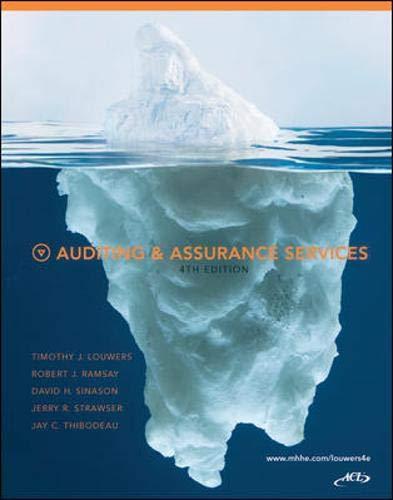Question
Which location provides Polaris the greatest cost advantage? Calculate the NPV of the three locations using a 10% discount rate. Would your recommendation change if
Which location provides Polaris the greatest cost advantage? Calculate the NPV of the three locations using a 10% discount rate. Would your recommendation change if the foreign exchange rate increased or decreased by 15%? What other factors should be considered in making this decision?
Polaris Industries Overview
American manufacturer of All-Terrain Vehicles (ATV's), Side-by-Sides, and Snowmobiles Based in Medina, Minnesota Established in 1954 Strong player in the powersports market - $10 billion industry: Polaris Industries dominates 20% of market - Competitors: Yamaha, Honda, Arctic Cat, Ski-Doo, and Harley Davidson Total revenue grew more than 20% in 2010 ($2 billion) - Expected to grow 8-11% in 2011
Case Overview
The economic slowdown in the United States (c. 2010) has put significant pressure on Polaris' overall profitability The company is considering whether it should follow their competitors and open a manufacturing facility in a lower cost country (Mexico or China) or continue manufacturing in the United States By the end of the current year (2010) Suresh Krishna (VP of Operations and Integrations) needs to recommend to the CEO whether Polaris should build a new plant abroad or remain in the U.S.
Products
Polaris' strength is in the powersports market - ATVs, Side by Sides, Snowmobiles 1992: Entered into personal watercraft business - Exited in 2004 due to lack of success 1998: Entered into parts, accessories and apparel market - Remains small percentage of Polaris' total revenue 1998: Introduced an on-road vehicle to compete with Harley Davidson
Current Operations
- Headquarters: Medina, Minnesota - Product Development and Innovation Center: Wyoming, Minnesota - Three Manufacturing Facilities: 1. Roseau, Minnesota 2. Osceola, Wisconsin 3. Spirit Lake, Iowa Operate internationally in Canada, Northern Europe, and Australia Sources almost 40% of components and materials from outside United States (2010) - Up from 30% in 2008 - Increased its LCC (low cost country) sourcing
Considerations for Manufacturing Location
Future Sales Growth Shipping Cost Location of Demand Communication "Made in America" Reputation Moving Abroad = U.S.A. Layoffs - Total of 60 workers would be laid off, each paid a one-time severance of $20,000
Courses of Action
1. Move Manufacturing to China 2. Move Manufacturing to Mexico 3. Continue Manufacturing in the USA
China Option - Pros
Excited about future sales growth in emerging Asian markets Lower wages than U.S.
China Option - Cons
Concerns on ability to collaborate with Chinese factory due to time-zone differences and cultural dissimilarities Wages increasing in China Long lead time, highly variable Shipping companies claim 20 days, range is 19-33 days 5% tariff on Chinese imports More expensive start-up cost than Mexico ($10 million)
Mexico Options - Pros
Closer proximity to U.S - Majority of Side-by-Side customers in Southern United States - Expected near-term growth in this region - Increasing Oil prices, cheaper shipping costs vs. overseas transit Stronger cultural familiarity compared to China - Easier in-person collaboration - Significantly shorter lead time than China (ranges from 2 to 7 days) - No tariffs on Mexican imports (NAFTA) - Cheaper start-up costs than China option ($9.5 million)
Mexico Options - Cons
Polaris has always been associated with a strong "Made in America" culture Would result in laying off American Workers
United States Remain Option - Pros
Would align with Polaris's strong "Made in America" culture Would keep jobs in the U.S. No up-front capital expenditure Close proximity to headquarters and product development facilities - Quick and easy collaboration with design engineers and technical staff
United States Remain Option - Cons
Higher wage costs Upper management concerned about manufacturing talent gap in U.S. - Difficult to find skilled technical talent, easier in Mexico and China Expecting future sales growth to come from international markets
Recommendation
Polaris Industries should move production to Mexico - Lowest long-run financial cost - Though initially it appears cheaper to remain in U.S: - Long-run labor costs would quickly surpass Mexico total costs - More strategic international transition as opposed to China - Monterrey is in close proximity to key customer groups - Facility in emerging market could help Polaris capture predicted future international demand
Step by Step Solution
There are 3 Steps involved in it
Step: 1
To determine which location provides Polaris the greatest cost advantage we need to calculate the Net Present Value NPV of the three locations using a 10 discount rate Additionally we will consider th...
Get Instant Access to Expert-Tailored Solutions
See step-by-step solutions with expert insights and AI powered tools for academic success
Step: 2

Step: 3

Ace Your Homework with AI
Get the answers you need in no time with our AI-driven, step-by-step assistance
Get Started


